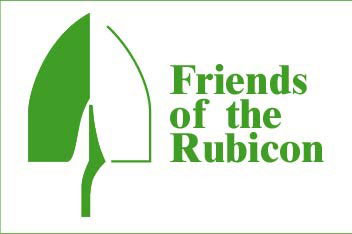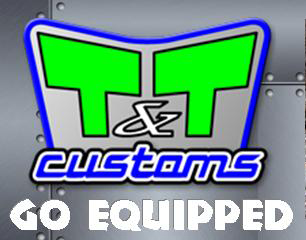|
|
|
|
If you have a choice (and money), get your rig set up with about a 4" lift and 33's, combined with some low gears to be most comfortable and do the least body damage. :)
LOCKERS: I suggest you have one locker in the rear. For me, with plenty of pavement driving, I am partial to ARB Air Lockers. They really do the trick for me. Plus I can disengage them while on pavement. I have ARB's front and rear. They have been a life saver for me on more than one occasion. If you're doing the trail with others, and you do not have lockers or limited slip, then put someone in front of you who does have lockers and can tow you out of bad spots. ACCESSORIES: Have a Hi-Lift jack and a CB along, as well as your first aid kit. Extra water is always a good idea, as well as some survival stuff (food, blanket, fire starter). Military MRE's are a great thing to keep in your rig. They last forever, and with a little hot sauce you can even eat them! Oh, and by the way, carry a camera -- even a throw away. I suggest this for a couple reasons: 1) if you bang up your rig on the trail, you can photograph the scene and damage for later insurance purposes; and 2) you can photograph any outlaw behavior that you want to report (Read more on outlaws and volunteer trail patrols). And don't forget your skeeter spray for summer trips -- they eat kids (just kidding). ;) LIFT/SUSPENSION: This is a never ending debate, but I suggest you tackle the trail with no less than 2.5 inches of lift. 3 or 4 inches would be better. Again, be prepared to do some bumping and grinding. Use a spotter; be careful; and dont' be afraid of a tow strap or of using your winch -- Warn is my choice. CLUBS/GROUPS: I recommend you tag along with a Rubicon-experienced group for your first time out. Get the books and maps that show the trail; stay on the trail; and learn from folks who have done it before. Join a club if that's what it takes. But don't do the Rubicon alone for your first time. Take a Jamboree or other commercial oufitter through if you want a fun experience and don't have a group to tag along with. WINCH: This is optional in my book -- although I never run without one and anymore, I consider a basic part of a vehicle buildup. Eventho I seldom use it, it's there if I need it. A good rig in front of me with a tow strap is very handy and faster than a winch somtimes. Nonetheless, I would not have a 4WD without a winch just for peace of mind. It's there if you need it. Warn is my choice for a durable, proven off-road winch. Also, when you use a winch, get and use a Winch Weight for your own safety. Further, having a rear attachment is crucial to good recovery. It never hurts to have a sturdy trailer hitch as part of your rig build up. RACK: While not trail essential, I consider a rack an indispensible part of my Jeep. I don't have a clue where I'd put stuff if I did not have a rack on the back. ***************** Here's an article I wrote on the subject of setting up your 4wd in general: Setting Up Your Four Wheel Drive by Del Albright "Lift it, lock it, winch it and rack it!" That's what I tell folks who aregetting started on building up their four wheel drive rigs. Minus a few technicalities, that's what it takes to have a "do-everything" kinda vehicle. How much does it cost? How long does it take? Well, the answers to those questions are easy: "How much money do you have?" and " How much time do you want to spend?" First of all, if you're new to the idea of building up your 4wheel drive,you'll find a lot of folks who agree with me that a little lift is the first step. This is usually accomplished through a suspension lift of anywhere between 2 1/2 inches to 4+ inches. You need some lift to get over the rocks and water bars and rough terrain that we like to travel. Stock height is made for good dirt roads without too many obstructions. Besides that, one of the reasons we like to lift our rigs is so we can put a larger diameter tire under us. My research (field and written) indicates that most of us start with 2 1/2 to 3 inch lifts, and 31" to 33" inch tires. Then if we continue to build our rigs, or try harder trails, we jump the lift to 4" to 6", and the tires to 35" or 37". You're getting pretty hard core here. Lift, and thus tire size, makes a substantial difference in what you can clear. The only thing that lifts your pumpkin above the rocks is tire size. The only thing that helps get bigger tires under your rig is lift. But there is a stopping point. There are all kinds of advantages AND disadvantages to making these modifications to what the factory engineers figured out for your rig. You need to do some homework on both before you decide. Radical lifts and tire changes do all kinds of weird things to your gear ratios and drive train. Some lifts (over 4") require lengthening drive lines and moving all sorts of parts around. Some tire size changes modify your gear ratio to the point that you are severely under-powered. So be smart, talk to folks and read a few books first. One good book to review is Brad DeLong's, 4 Wheel Freedom, the Art of Off Road Driving (Paladin Press). Brad gives you several scenarios for modifying your vehicle and lists the many advantages and disadvantages related to gearing and lifting. You can also get great ideas from the internet, such as the many great four wheel drive sites that have grown in popularity over the last year or so. "Locking" your vehicle is the next step. By that, I include such things as the many options in limited slip, positive traction, and locking devices. The point is to give your vehicle some of its real potential as a four-wheel drive. As a starter, many off-roaders recommend having some sort of locking (or limited slip) differential in at least the rear axle. The front axle can wait until you get more radical or have more money! I use ARB Air Lockers in my rear differential and I have noticed a substantial improvement in trail ability. My partners use everything from Detroits to Lock Rites to Posi-traction to Eatons to about anything you can think of. Again, you have to inventory your wallet first. Also, you have to ask yourself just how much off roading you want to do. For many folks (including some Rubicon users), a simple limited slip in the rear is enough. . Without a differential modification, your current rig is really still a two-wheel drive vehicle. By modifying the rear axle, you've grown to the 3-wheel drive. And by "locking" both front and read diff's, you've now graduated to a true four wheel drive. Naturally, most off highway four wheel drive enthusiasts sport a winch on the front bumper. Some even have one in the rear. But for the average person, even SUV owners, an electric (or now hydraulic) 8000 to 12000 pound winch is nearly a necessity. If you "winch it", you'll find yourself having an increased confidence in where you go (and get stuck). You can also clear trails and pull out your buddies, let alone haul fire wood into camp. Lastly, for those of you who can't help but take the kitchen sink with you when you go camping/four wheeling, then you'd best add some sort of cargo carrying device on your rig. For short wheel base utility rigs, a rack on the back works great. You can carry ice chests, camping gear, fire wood, gas and water cans, etc. outside of your rig so the family dog can have the back seat! For SUV folks, you may want to consider a cargo rack on top of yourvehicle. Then you can really haul your whole garage full of stuff!! But by "racking it", you've increased the available space so that overnight trips are certainly a lot more comfortable. Oh, and obviously, if all your gear is now outside your rig, and you don't have a dog, then your back seat is now available for the in-laws. Yes, that's one consideration (smile). Now I know some of you hard core off highway gurus are snickering at the simplicity of some of these changes. Well, I grant you that the modifications can go on and on until your savings account is depleted, your garage is full of old parts, and your rig has easily doubled in value. For the average person, a "lift it, lock it, winch it, rack it" approach can be done for not that much money and time. And it'll make a huge difference in the performance of your vehicle. Again, I must emphasize that there are complete books on this process, but this will give you a starting point. So count your money and dig in!! Good luck.
|
||||||||||||||||||||||||||||||










